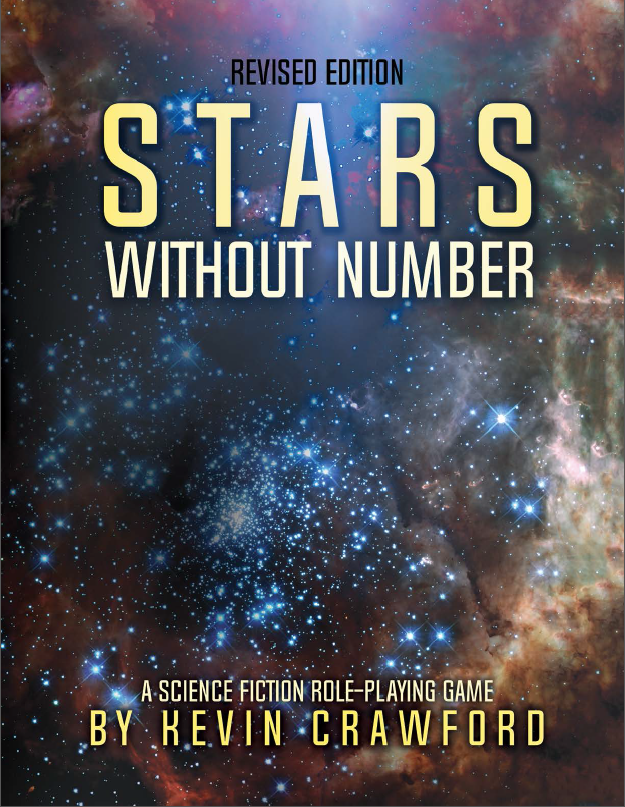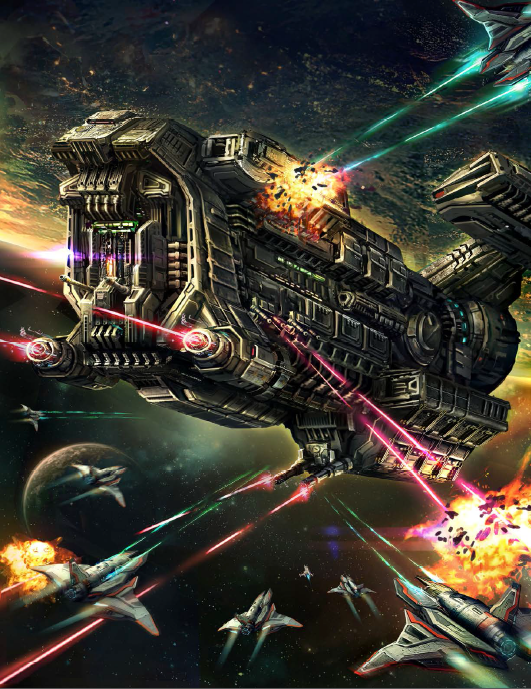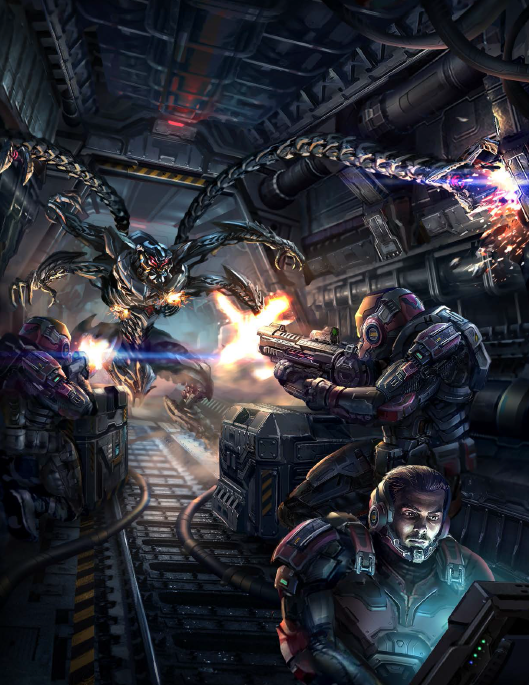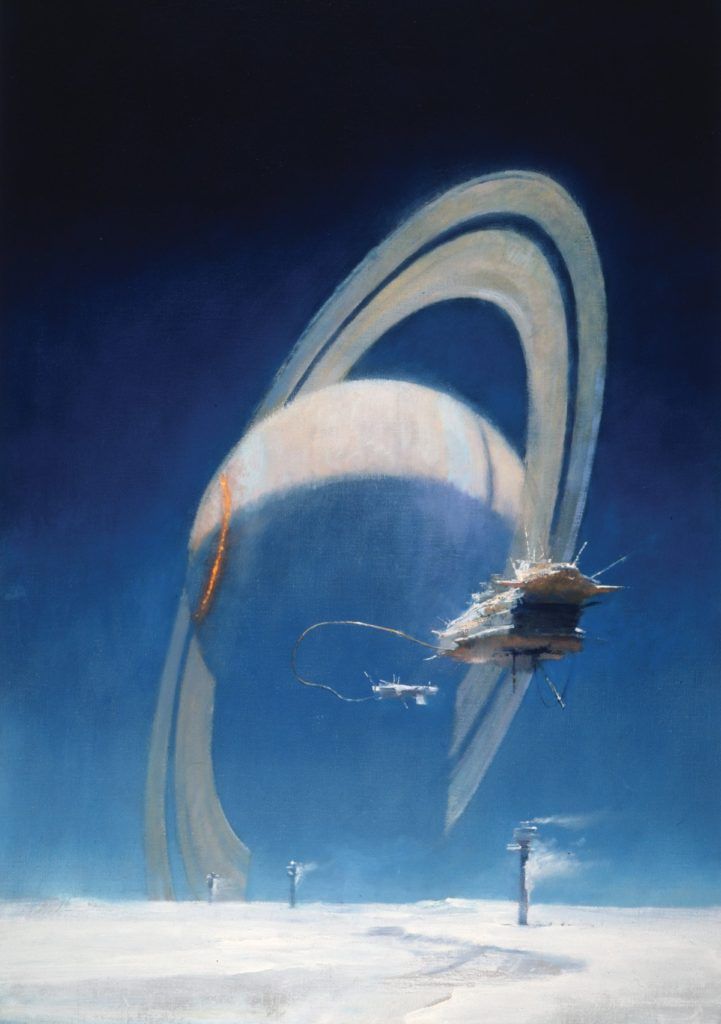RPG Review - Stars Without Number Revised Edition
Note: Apologies to anyone looking forward to a new Thursdays in Thracia this week. Unfortunately we had to cancel our last session, so this week and next I’ll be posting other stuff. We’ll be getting back to it after that!
Originally released in 2011, Kevin Crawford’s Role Playing Game, Stars Without Number, has earned a reputation as a great toolkit for sandbox style science fiction gaming. Anywhere someone asks for sci-fi game recommendations online, Stars Without Number is mentioned quickly and frequently in the responses.
This year, after a successful Kickstarter, Crawford released a revised edition of the game, making a variety of changes and updates, big and small. I can’t say much about the original, as I’ve never played it, but I’m six sessions into my Revised Edition campaign, and can’t wait to run it again.
[caption id=“attachment_363” align=“aligncenter” width=“625”] Stars Without Number: Revised Edition, by Kevin Crawford[/caption]
Stars Without Number: Revised Edition, by Kevin Crawford[/caption]
The Basics
Stars Without Number is built on a mechanical core that looks a lot like Dungeons & Dragons. Depending on your taste, that is either a huge selling point or a huge turnoff. The game uses this core as a familiar starting point, but drifts the mechanics in interesting ways to provide a vast amount of potential.
In one major departure from D&D, Stars Without Number uses two six-sided dice (2d6) to resolve skill checks (basically anything outside of combat), and a twenty-sided die (d20) for combat, which is mechanically identical to combat inD&D, outside of some minutiae. By foregoing a unified mechanic for all situations, Stars makes combat situations and character skill use feel distinctly different. The contrast between the smooth probability curve of 2d6 and the arbitrary swinginess of a d20 means that players can be at least somewhat confident in their characters’ skills, but that combat is always a scary, random mess. It’s a clever decision that uses basic dice math to reinforce an important lesson in the game: fights are dangerous and random, don’t get into one unless you know you can win.
Stars Without Number is old-school in a lot ways, but it really shows its colors in the deadliness of its combat. Starting characters, especially ones not specialized in combat, can be paper thin, and a lucky shot from some pirate mook with a laser pistol can absolutely kill one of them.
Fortunately, guns are just one tool in a massive box of tools that Stars Without Number gives players to solve their problems. While the game only has three core character classes for players to choose from, which seems limiting, each class is actually extremely flexible due to the skills available, and to Foci, a wide range of specific abilities and maneuvers with which players can customize their characters. Thus the Warrior class covers any character archetype focused primarily on combat, and there is room for everything from grizzled space marines to unarmed monks to special-ops snipers to axe wielding barbarians from a forsaken planet. The Psychic and Specialist classes each offer an even greater range of freedom.
I haven’t been able to put the starship combat system properly through its paces yet, but it looks quite solid. Starship combat is notoriously difficult to get right in games, and the system in Stars Without Number is designed to keep everyone involved each turn, without bogging the players and GM down in layers of uninteresting crunch. Essentially, each function of the ship is overseen by a player character. So one PC is flying the thing, while another fires the guns, another operates electronics and sensors, etc. and each can have an impact on the fight and support each other. I can’t wait to take them for a proper spin. One thing I appreciate is that range and position are completely abstracted. No range bands, no flanking, no visual representation of any kind necessary. It’s all compartmentalized into the individual actions taken by the players or the enemies.
[caption id=“attachment_401” align=“aligncenter” width=“531”] Pewpewpewpew. PEWPEW. BZZANK! Illustration from Stars Without Number[/caption]
Pewpewpewpew. PEWPEW. BZZANK! Illustration from Stars Without Number[/caption]
The Setting
The Stars Without Number core rulebook is relatively light on setting history and lore for a book of its size. Over just few pages, it describes a future-history of humanity leaving earth to colonize the stars, then suffering a major catastrophe that breaks up their vast interstellar empire. In the assumed present-day of the game, individual worlds in human-colonized space, isolated from each other for hundreds of years, are just reaching back out and coming together again.
It’s admittedly an extremely generic setting and history, but in Stars Without Number this blandness of lore is a feature, not a bug. The default setting is designed, as much as any other part of the game, to be a tool. It’s a setting that, because of the splintering of humanity into small pockets, provides easy justification for any flavor of science fiction out there. Different worlds have different technology levels, so your game can look like anything, from Firefly to Alien to Star Trek, and be accommodated fictionally. Using the optional rules for more heroic characters found in the paid version of the book, you could even run a Star Wars style science fantasy game with little trouble.
If you love detailed setting books with your games, stuffed with deep lore and history, you’ll likely be disappointed by what Stars Without Number has to offer. If you’re like me, on the other hand, you find a ton of lore to be more trouble than its worth, and will appreciate a simple, elegant back story that gets questions like “How does faster than light travel work?” and “Why do some people have psychic abilities?” out of the way so you can get to building your own little corner of space and watching the players burn it to the ground.
Game Mastering
The most interesting features in Stars Without Number are the tools it gives the Game Master to set up and run a science fiction sandbox game. Where many games give you the rules for players, then leave the GM with some bland tips about “saying yes” and “crafting a story,” Stars Without Number provides real rules and processes to make the universe feel alive and to generate adventure hooks.
The game’s default assumptions are that you are running a relatively open sandbox-style game, where the players have a huge array of options when it comes to where they go, who they talk to, and how they cause chaos. This kind of play style emphasizes player agency, but can be a huge burden on the GM to prepare.
To support creating and running a sandbox, Stars Without Number has two major systems for the GM: the Sector Creation system and the Faction system. In sector creation, the GM can follow a step by step process involving random tables to create a hex map representing a sector of space. You’ll place star systems randomly, then place a planet in each star system, then generate physical details about the planet, and finally each planet is assigned what are called “tags.” Each tag is like a theme for a particular world, and each world gets two tags. So you might have a world with the tags _M__egacorporations_ and Great Project, which indicate a world ruled by massive corporations, but one on which the whole population is devoted to some massive undertaking. In my campaign, the above tag combination is a cyberpunk world of hyper-dense cities completely sealed off from the exterior, because the planet is an uninhabitable ball of burning rock, too close to its sun. The corporations are all competitors, of course, but all of them also pay in to a massive project to reverse-engineer and rebuild one of the old jump gates from before the cataclysm.
Each tag also comes with robust lists of NPCs and plot hooks with which to build out adventures and complicate your PC’s lives.
The Faction system is a whole detailed mini game that the GM can play by themselves between sessions in which you create the major factions in the sector, give them actual stats, and play out their conflicts using units and strategies called Assets. While a bit complex and fiddly compared to the rest of the rules, the faction system is a brilliant way to inject uncertainty into the GM’s role, and to create a world that feels alive and in-conflict, as opposed to creating plots that revolve solely around the PCs.
Along with world tags, the faction turn provides a great engine for session to session adventures as well. In my campaign, the players are friends with an NPC who is a member of an uprising against the nobility on a particular planet. I have had her ask favors of the PC’s involving destroying or undermining particular assets of the nobility, which then in turn can affect the faction game on a larger scale.
Down the line, the rules even suggest letting high-level or retired PCs lead factions of their own. It’s a great way for long term players to get invested in the game world at large, and a way for things to happen in the universe that aren’t all up to the GM just making a judgement call.
Beyond those systems, Stars Without Number also provides great, simple tables for creating NPCs, monsters, and other enemies nearly instantaneously, in a way that anyone comfortable with the old D&D conceits of Hit Dice, Armor Class, and Saves will be able to whip them on on the fly when things take an unexpected turn. This kind of thing can really make a game for me, especially in a sandbox style.
[caption id=“attachment_400” align=“aligncenter” width=“529”] An illustration of some badasses fighting a thing in a corridor while their friend hacks. From Stars Without Number.[/caption]
An illustration of some badasses fighting a thing in a corridor while their friend hacks. From Stars Without Number.[/caption]
The Book
For all its brilliance as a science fiction toolkit rules set, I wish Stars Without Number were a bit more inspired as a physical product. There are no glaring problems with the book, but there’s also nothing particularly noteworthy or interesting about it. It’s as though the game’s ability to be highly adaptable made its way into the book as an almost deliberate blandness. The art in the book is fine for the most part, and occasionally cheesy or weirdly static. The font chosen for the headings feels like a free font picked from a drop-down menu because it was the most generally science-fictiony. Still, the book is a large, full-color hardcover, and it is nice to have at the table.
As what is becoming one of my favorite games, I wish it just made more of a statement. Sitting on my shelf among Dungeon Crawl Classics, Veins of the Earth and Torchbearer, it doesn’t beg to be picked up and flipped through in the same way, and on its own doesn’t get the imagination firing the way those titles do. The 70’s Sci-Fi Art twitter account makes me want to play Stars Without Number far more than looking at Stars Without Number does, which is kind of a bummer.
[caption id=“attachment_399” align=“aligncenter” width=“525”] If you really want inspiration for running Stars Without Number, look at paintings by John Harris for a while.[/caption]
If you really want inspiration for running Stars Without Number, look at paintings by John Harris for a while.[/caption]
Other than that, I find the table of contents a little too broad, and occasionally find myself digging through paragraphs of text to find important rules that could have been called out a little better. Lastly, I want nothing more for this game than a completely redesigned character sheet. For a game that is relatively simple on the player-facing side, the character sheet is a crowded, unintuitive jumble of information. It works well enough when you get used to it, but it’s outright intimidating to new players.
Despite some shortcomings in its packaging, Stars Without Number is really an incredible achievement for a single designer, and I can’t overstate that enough. It’s a rugged, adaptable ruleset that I see myself playing over and over for years to come. It’s a lifetime of sci-fi sandbox gaming in a single book.
Perhaps the most amazing thing about it is that it is basically free as a PDF. The paid version of the game includes a few interesting add-ons, like rules for mechs, transhuman games, wizards in space, and building detailed societies, but other than that the free PDF version is absolutely a complete and identical set of rules. Check them out, and if you like what you see and want more, or if you just need a physical book at the table, grab the full version.
Stars Without Number Revised: Free Version
Stars Without Number Revised: Deluxe Version